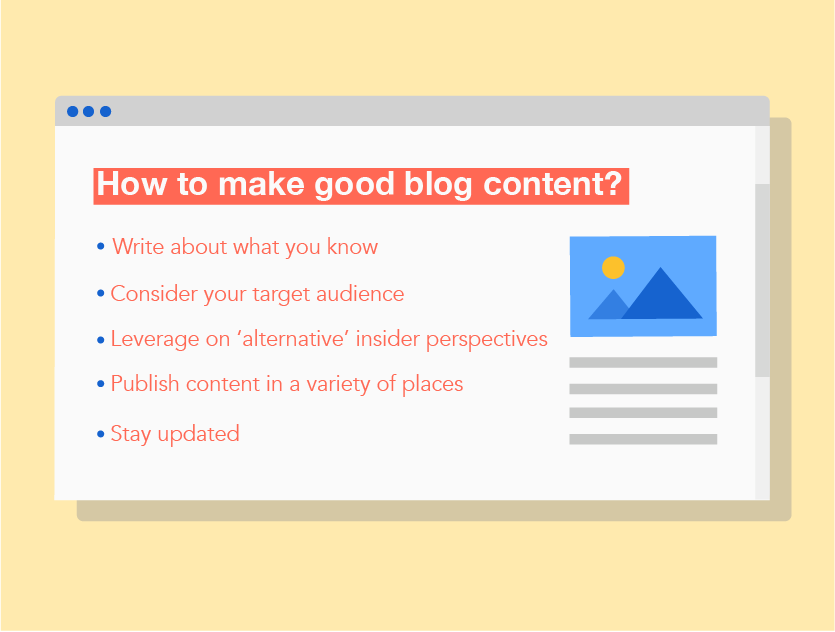

How To Write a Good Blog
A well-written blog will still stand out among the various new ways of delivering content.

With the proliferation of social media and bite-sized content, you may think the approach of spreading your message via a blog is no longer relevant. Think again, it may be an older format but it’s still effective — if you write them well.
“Attention spans are getting shorter, but sometimes as a reader, you would still want descriptions and explanations for certain things that give you the answers you are looking for — and fast. The control-F function certainly comes in handy when you want to scan through it using certain keywords,” Click2View’s Editorial Content Director, Michelle Cheong said.
“Although the demand for blogs is not as high as it used to be, given consumers’ changing preferences in consuming content via podcasts, videos, and infographics, blogs are still very much relevant today.
“It helps increase site traffic and boost SEO with Google’s algorithm,” she said. “Therefore, it should not be a surprise if blogging is still the second most common form of media used in content marketing strategies.”
Blogs also play a crucial role in the buying journey process; 60% of buyers will seek out a product after reading a blog about it.
How to make good blog content?

Write about what you know
Authenticity matters, and it’s crucial you write about what you know, based on your own experiences and knowledge.
Even if you feel the information is universal, what can set you apart is how you’ve applied it to your situation and what you’ve learnt from it. Your unique experiences allow you to provide insights on niche topics that you specialise in, especially if they are distinct from those offered by your competitors.
You’ll come across as being much more credible if you can demonstrate your industry knowledge — which goes a long way in building trust with your consumers and convincing them you know your stuff.
Don’t forget to back up your blog post with the happenings in your industry, be it case studies, surveys, or reports. That way you are not writing an opinion piece but a credible article supported by facts, all while enhancing your brand image as a reputable source of information within your industry.
That is why doing research beforehand is crucial. “Research can be from anywhere; Google searches, interviews with experts, or the clients themselves. There’s really no limit. Sometimes, through research, you can uncover something new that makes you tweak your chosen angle. It happens to me too!” Michelle said.
Consider your target audience
To start it might be useful to take a good look at your buyer personas. What is your audience interested in? What are some major pain points that they face? What questions do they have? Once you’ve figured out what information they need, you can evaluate what you know and what’s worth sharing with them.
Due to your expertise, you are in a much better position to inform and educate your audience regarding the latest developments in your field. Therein lies the value you can provide, and they’ll appreciate it because you’re not necessarily asking for anything in return. (Or not yet anyway).
Leverage on ‘alternative’ insider perspectives
With the division of labour, every company has numerous employees who specialise in different areas. Their specialities provide them with a unique point of view that you can tap on to share with your audience.
For instance, we’ve leveraged the specialities of our Lead Producer, Alex Chua, on webinars and live streaming to create blog content. It demonstrates what we can offer to the audience — we’re capable of providing the right services to allow audiences to hold virtual events in the ongoing pandemic.
That specialised information can give your content an edge over your competitors.
Publish content in a variety of places
Wherever your audience is, you should be there too. While LinkedIn is a popular place to publish articles, you should also aim to create a comprehensive content hub on your own site, as well as cross-post on other channels like Medium.
By publishing your content on different platforms, it will be seen by more people. This will ultimately lead to better customer engagement. Reading a blog is one way your audience will find out more about your business, so writing a good and consistent piece is a must.
It also helps if you spice up written blog content with relevant infographics or videos — like this one we filmed on tips for writing good blog content.
Mix of updated and evergreen content
If you want to be seen as a leader in your industry, you need to keep up with the times. Stay in the loop on every new development or trend that’s just emerging in your field. This will ensure you’re sharing knowledge that’s always fresh.
Timeliness matters, and if you’re able to establish yourself as one of the ‘early’ sources of reliable information, it’s likely that your audience will keep returning to you when they need to know about the latest updates.
Aside from updated content, consider creating evergreen content, which is timeless, a piece of content that is always relevant. This will drive your organic traffic and SEO; a mixture of both is the way to go for your blog content.
Use a mix of gated and ungated content
Even with a blog, the eventual goal is to encourage conversions. But no one likes a hard sell, so use a mix of gated and ungated content to appeal to your audience.
Gated content requires your audience to fill out a form to access it. Meanwhile, ungated content is the kind that can be publicly accessible without the need for personal data exchange.
With ungated content, there can be numerous calls to action that guide readers to explore other pages on your site, offering information about your business and easing them through the buyer’s journey.
If you can provide meaningful information with ungated blog content, your audience will be convinced of the value you can offer them, and be more open to exchanging their information for access to your gated content. That’s where you can generate leads.
Our Experience
Recently, Click2View finished an editorial project with one of the leading multinational companies. We were tasked with writing blog pieces on lifestyle and wellness that would be published on their portal. “We brainstormed individually and as a team and came up with a list of possible topics and angles to target. Some were on the latest trends in food and beverages, like a veganism diet or probiotic drinks,” Michelle remembered.
Initially, the client wasn’t too keen on the idea, as they didn’t know much about the topics and didn’t think their audience would be interested. Ultimately, we convinced them that these are the trends and buzzwords people are looking for. In the end, the articles resounded very well with their readers, and in fact, the veganism piece is still one of the top-performing articles on their site today.
It all comes down to what you discovered during your research to decide what to write. “See what people are saying, what the trends are, controversies or issues that would be interesting to people, what people want to know most about that topic,” says Michelle. From there, you can brainstorm what the possible topics are. Doing so helps you to come up with ideas for your current and upcoming blog pieces.
Staying relevant and writing pieces that resonate with audiences and answering what they want to know increases your chance of getting recognised online. “Remember to adhere to SEO practices to ensure good rankings in search engines,” said Michelle.
It’s all about authenticity
In the end, the best blog content is genuine — it should always be backed by reliable information from reputable sources, imbued with personality and guided by insider experiences. Looking to improve your blog content? Reach out to our CEO Simon Kearney at [email protected]
Read more from Click2View:
- The Consciousness As Content: Going Full Steam Meta In The Metaverse
- Why All Events Will Be Hybrid
- Webtoons: The Latest Incarnation of The Korean Invasion
- Is It Better To Pre-record or Livestream Your Virtual Event?
Sign up to our newsletter for a weekly update on the latest content marketing news. Don’t forget to subscribe to our YouTube channel too!
Click2View is Southeast Asia’s premiere full-service independent B2B content marketing agency servicing clients like Microsoft, Google, Visa, Prudential, and the Lee Kuan Yew School of Public Policy.








